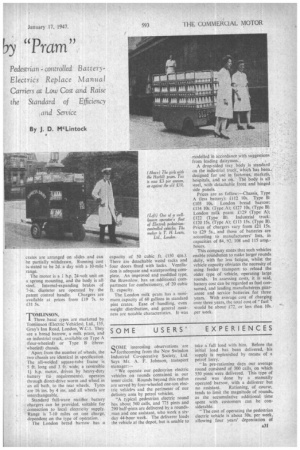SOME USERS' EXPERIENCES
Page 33

Page 34

If you've noticed an error in this article please click here to report it so we can fix it.
SOM E interesting observations are forthcoming from the New Swindon Industrial Co-operative Society, Ltd. Says Mr. A. F. Johnson, transport manager:—
" We operate our pedestrian electric vehicles on rounds contained in our inner circle. Rounds beyond this radius are served by four-wheeled one-ton electric vehicles and the perimeter of our delivery area by petrol vehicles. "A typical pedestrian electric round has about 560 calls, and 775 pints and 290 half-pints are delivered by a roundsman and one assistant, who work a sixday 44-hour week. The deliverer loads the vehicle at the depot, but is unable to take a full load with him. Before the initial load has been delivered, his supply is replenished by means of a petrol lorry.
"in pre-rationing days our average round consisted of 300 calls, on which 550 pints were delivered. This type of round was done by a manually operated barrow, with a deliverer but no assistant. Rationing, of course, tends to limit the magnitude of rounds, as the accumulative additional time spent with customers can be considerable.
" The cost of operating the pedestrian electric vehicle is about 30s. per week, allowing four years' depreciation of capital charge and all other costs (tax, insurance, interest, tyres, repairs, and replacements, maintenance, etc.)."
The Society finds that, after capital charge has been wiped out by depreciation, repair costs nearly balance the original depreciation figure and the 30s. per week is steady throughout the life of the vehicle. Week-to-week costs, it is stated, are light. Charging costs should not exceed 5s. per week for seven days' service. About four years' service has been obtained from batteries and there has been no motor trouble.
Some earlier types are stated to have been too frail to withstand starting torque, and there were transmission and hub troubles. These faults have been remedied with present-day vehicles. " Robust traction batteries and nothing lighter than extra-heavy-duty tyres are suitable," says Mr. Johnson.
USE of electric prams for milk delivery by Faversham and Thanet Co-operative Society, Ltd., began in June, 1943. Mechanical trouble, it is stated, was mostly concerned with the driving hubs, the studs of which had to be renewed. Larger studs were fitted and this removed the weakness.
There was also a good deal of trouble with punctures, and this was cured by ordering vehicles with wheels having removable rims.
The more recent type of vehicle purchased can be driven in either direction. but the Society's drivers prefer to walk behind rather than in front.
As regards charging, a case is quoted in which a motor generator is used and • a figure of 4s. 8d, per week per pram has been recorded.
ACOMPANY that is strong in its praise of electric prams is A.1 and Dollis Dairies, Ltd., Whetstone, London. N.20. The fleet in this case consists of six Graiseleys—two of which have been acquired recently and four are about
two years old—two Manulectrics (about five years old), and one Lewis, which is rather older than any of these.
Roundsmen average something like five miles per day in fairly hilly country, from depots at Southgate, High Barnet, and Church End. The vehicles give little trouble and have at least twice the capacity of the old hand barrows.
Whereas in the old days a roundsman would start work at 6.30 a.m. and call back at 9.30 a.m. for refilling, and then continue his day's work, he now leaves at 8 a.m. and finishes at about 3 p.m. without a refill. On days when he is collecting cash, his time is, naturally, longer, but this does not affect the question.
A staff of two or three men suffices
for all maintenance, which is of a modest order. It has never been necessary to return vehicles to the marrnfacturers, and spares are easily obtainable. Batteries have lasted something like five years, with servicing by the makers from time to time.
ANOTHER operator, in describing his experiences, says: "These trucks replace carrier cycles and a tricycle, which were never satisfactory. We have a three-wheeler and a fourwheeler, and have found the latter to be well worth the additional taxa
tion, as it is easier to handle on the road and is preferred by the roundsman."
This operator, the King's Lynn and District Co-operative Society, Ltd., says that it is not advisable to try to carry a greater load than that recommended by the makers, as overloading causes trouble. It is stated that, in the opinion of the concern, these vehicles are ideal for town delivery in fairly compact districts.
As an example of the more varied uses of the electric pram, it may be noted that Bailey Education Committee employs this type of conveyance for
transporting cooked food from central kitchens to various schools. Graiseleys are operated, and have proved entirely suitable for the work.
Special bodies were fitted to the threewheeled chassis. A forward compartment 3 ft. 4 ins. by 1 ft. 6 ins. by 2 ft. 10 ins, carries soup, pastries, and puddings, the last-mentioned on shelves. A rear compartment, divided by a vertical partition, carries cooked meals. It measures 3 ft. 4 ins. by 2 ft. 10 ins. by 2 ft. 10 ins.
An illustrated description of the vehicle was published in "The Commercial Motor" on February 9, 1945.












































































